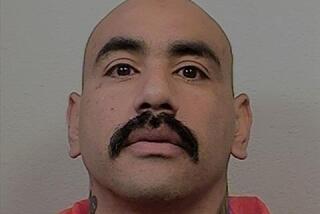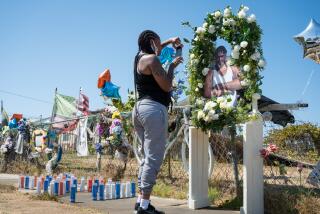Late Officers’ Words Live On
If not for the letters, the memories might have died last August when former El Monte police Officer Terry Long lost his battle with cancer.
Instead, the voices of two men, both now dead, speak from the tattered pages.
Thirty-four years ago, Long had been pulled from a bloody shootout by a fellow officer, Manuel “Tony” Arceo. Arceo saved his life, but the violent ambush left Long paralyzed.
In the days afterward, Arceo sat down with a steady hand to offer his friend and colleague encouragement.
“Listen Partner, the road ahead of you will be long and hard to overcome. I know within myself, from knowing you for almost two years that you will make the best of your life,” he wrote in neat black ink.
Four years later, Arceo risked his life again. This time, he was killed by a ricochet as he tried to bring bulletproof vests to officers under fire.
Long, tormented by news of Arceo’s death, wrote a belated letter of thanks.
“One thing that you may not know, however, is that as I laid there that night, I said goodbye to my wife and kids cause I really thought I was going to die,” Long wrote in blue cursive ink. “I knew that I was bad hurt and if you hadn’t gotten to me when you did I probably wouldn’t be here now.”
The private thoughts became part of the public record when the letters were donated to the El Monte Police Department a few weeks ago by Long’s estate. Now framed, they will soon be on display at the police station on Valley Boulevard.
“When I read the letters, I was really touched,” said Police Chief Ken Weldon, who was an officer when Arceo and Long were on the force. “It sent chills down my spine.”
For Weldon and others in the department, the letters were a reminder of a difficult and violent period in the history of El Monte, a working-class bedroom community about 15 miles east of downtown Los Angeles.
“There’d be shootouts where both sides emptied their guns, knockdowns and pistol-whipping contests,” El Monte Assistant Police Chief Ken Jeske, a close friend of Arceo, said.
*
On June 18, 1970, Long was 28 and a two-year veteran of the department who had previously served as a Navy medical corpsman.
Long and an unarmed 19-year-old police cadet, Kent Livingston, were dispatched to Valley Boulevard and Monterey Avenue at 3:15 a.m. to assist another officer in what appeared to be a routine arrest of a drunk teenager.
“All of a sudden, Kent noticed some men with guns trained on us across the street,” Long told The Times in a 1976 interview. “We radioed for assistance, and I went to the back of the house where the men were. I rounded a corner and ran straight into a man with a gun. He fired first, and that’s about all I remember.”
A .30-caliber slug tore into Long’s spine at point-blank range and paralyzed him from the waist down. Then Arceo arrived, dodging bullets as he dragged Long to safety.
The gunman, later identified as Massey Albert Enciso, 25, was shot three times in the back and was also paralyzed from the waist down. Authorities alleged that he belonged to the Brown Berets, whose members dressed in military-style tunics and headgear.
The Brown Berets rose to prominence in East Los Angeles in the late 1960s, with the goal of battling racial discrimination and the Vietnam War as well as protecting Chicano neighborhoods. At its height, the Berets had 5,000 members nationwide and were perhaps most famous for the group’s “invasion” of Catalina Island in 1972 to claim the tourist spot as Mexican territory.
Long and police officials suspected that Enciso and the drunken teenager had been working together to set up the officers. Enciso was later convicted of attempted murder and served five years in prison before being paroled, though authorities could not prove that he and the teenager had been in collusion.
Shaken by the shooting and struggling to comfort Long, Arceo put pen to paper.
“For the past week, I have been unable to be with,” he wrote in his letter to Long. “I can’t get the whole ... thing out of my mind, when I saw you lying in the field on your back I thought you were dead but then I heard you breathing and I thanked God.”
Long recovered slowly. When he left the hospital, the Police Department asked him to return as a dispatcher. However, he said, “I just couldn’t see myself hanging on. I started thinking about law school.”
*
Long was attending Ventura College of Law on July 9, 1974, when he heard the bad news.
A man wielding a machete barricaded himself in a Baldwin Park pawnshop, taking five hostages and shooting firearms he grabbed from the shelves at officers outside. His old police buddy, Tony Arceo, was off duty at the police station, waiting to make a court appearance, when he heard about the shooting. He raced to the scene after learning the officers needed bulletproof vests.
“He didn’t even wear one himself that day,” Weldon recalled.
Arceo, 31, was standing in a doorway near the pawnshop when he was struck by a police bullet that ricocheted into his chest, killing him. The hostage-taker, J. Michael Barola, 22, was shot dead when he ran out of the store firing a handgun and a rifle.
Arceo was athletic, smartly dressed and enjoyed the single life by the beach in the South Bay. He never married, Jeske said, because he felt obligated to take care of his immigrant parents in Torrance. The day he died, he was supposed to receive a commendation at City Hall for rescuing an elderly blind couple from their burning mobile home.
As he tried to come to terms with Arceo’s death, Long decided to write a letter of thanks to honor his fallen comrade.
“I consider myself a lucky man, Tony, because I have had the opportunity to be a policeman and work beside you and men like you,” he wrote. “It was short, but it was ... sweet and I’m glad you were part of it.”
Long stayed in law school, graduating in 1975. He found it difficult at first to transition from police work to law; he had trouble representing people he was used to putting behind bars. He later said he understood that the legal profession was more about protecting the constitutional rights of citizens, including law-breakers.
He came to the conclusion that not all police were fair. “If policemen would look at their errors as a lesson instead of getting mad at the courts, they would go out and do much better the next time,” he said in the 1976 interview.
All the time, he said he never forgot his debt to Arceo. At his home, Long displayed several pictures of Arceo and had Arceo’s letter framed.
Long, who practiced law for 20 years and raised three children, died in August at age 62. The executor of his estate found the letters and donated them to the El Monte Police Department.
Weldon e-mailed copies of the letters to his staff last month.
He told his officers that Arceo and Long “represented our department with the highest level of dedication.”
More to Read
Sign up for Essential California
The most important California stories and recommendations in your inbox every morning.
You may occasionally receive promotional content from the Los Angeles Times.











